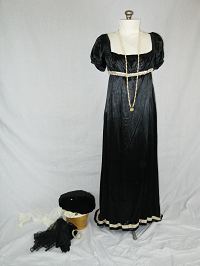1809
Ever since they became an institution in the late 18th century, fashion plates continued to illustrate the latest modes. Two French magazines provided the inspiration for this black velvet evening gown from 1809. The flowing classical line of the early years has begun to straighten and grow more angular. The Greek key braid adds interest along the hemline accentuating a small train. Gold and silver trim were used on evening wear.
A new form of construction was introduced around 1800 with the bodice fastened at the center back. By 1810 the stomacher was obsolete. Classical lines were preserved by wearing long shawls and scarves for warmth, especially by the fashionable, who wore their dresses very low and their sleeves very short. A great deal of practice and dexterity were essential for the well “draped” woman. The first “kashmir” wool shawls were sent from Egypt by Napoleon to Josephine. They were expensive but soon were imitated by manufacturers in France and Scotland. The archaeological excavations of Pompeii, an Italian city buried by a volcanic eruption in AD 79, influenced jewelry designs with classical Greek and Roman elements. Hair was worn short and curled, and was topped with a fanciful turban for evening wear, such as this one of black velvet and satin and trimmed with ostrich feathers and jewels.
Footwear underwent great changes after the American Revolution. High heels disappeared and flat soles were worn. Many were so wide they had to be kept on by ribbons tied up the leg.
Most under clothing pads and corset had been cast off after the French Revolution. An important innovation in this period was the introduction of drawers for women. Drawers reached to just below the knee. Elastic cotton drawers are advertised in 1806. Since rubber elastic had not been invented yet we can only conclude these were knitted drawers. As with most new fashion, they were initially limited to the upper class and considered a status symbol. The scanty dresses could no longer conceal the pocket hung around the waist, so they were replaced by a small handbag, called a reticule, or “indispensable.”
Click photo for detailed views.


